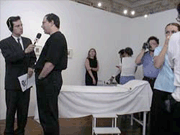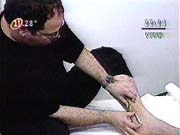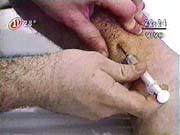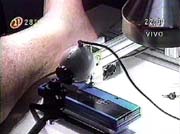Abstract
"Time Capsule" is a work-experience that lies somewhere between a local event-installation, a site-specific work in which the site itself is both my body and a remote database, a simulcast on TV and the Web, and interactive webscanning of my body. The live component of the piece was realized on November 11, 1997, in the context of the exhibition "Arte Suporte Computador", at the cultural center Casa da Rosas, in Sao Paulo, Brazil. "Time Capsule" was carried live on the evening newscast of the TV station Canal 21 and on tape by two other TV stations (TV Manchete and TV Cultura). The webscast was transmitted by Casa das Rosas.
 |
 |
The object that gives the piece its title is a microchip that contains a programmed identification number and that is integrated with a coil and a capacitor, all hermetically sealed in biocompatible glass. The temporal scale of the work is stretched between the ephemeral and the permanent; i.e., between the few minutes necessary for the completion of the basic procedure, the microchip implantation, and the permanent character of the implant. As with other underground time capsules, it is under the skin that this digital time capsule projects itself into the future.
The Procedure
When the public walked into the gallery where this work took place, what
they saw was a medical professional, seven
 |
 |
 |
Memory and Information
Not coincidentally, documentation and identification have been one of the main thrusts of technological development, particularly in the area of imaging, from the first photograph to ubiquitous video surveillance. Throughout the nineteenth and the twentieth centuries photography and its adjacent imaging tools functioned as a social time capsule, enabling the collective preservation of memory of our social bodies. At the end of the twentieth century, however, we witness a global inflation of the image and the erasure by digital technologies of the sacred power of photography as truth. Today we can no longer trust the representational nature of the image as the key agent in the preservation of social or personal memory and identity. The present condition allows us to change the configuration of our skin through plastic surgery as easily as we can manipulate the representation of our skin through digital imaging, so that we can now embody the image of ourselves that we desire to become. With the ability to change flesh and image also comes the possibility of erasure of their memory.
Memory today is on a chip. As we call "memory" the storage units of computers and robots, we antropomorphize our machines, making them look a little bit more like us. In the process, we mimic them as well. The body is traditionally seen as the sacred repository of human-only memories, acquired as the result of genetic inheritance or personal experiences. Memory chips are found inside computers and robots and not inside the human body yet. In "Time Capsule", the presence of the chip (with its recorded retrievable data) inside the body forces us to consider the co-presence of lived memories and artificial memories within us. External memories become implants in the body, anticipating future instances in which events of this sort might become common practice and inquiring about the legitimacy and ethical implications of such procedures in the digital culture. Live transmissions on television and on the Web bring the issue closer to our living rooms. Scanning of the implant remotely via the Web reveals how the connective tissue of the global digital network renders obsolete the skin as a protective boundary demarcating the limits of the body.
Incorporating Biotechnology
To consider some of these questions, we need only to look closer at the present, not the future. If one's unique signature is in the genetic code, in order to leave an undeniable authentic mark one doesn't need to sign his or her name in blood. A special pen containing ink infused with one's own DNA, which is currently available to fight counterfeiting, is all that is needed. Radar tracking, or the use of tagging and tracking technology to monitor at a distance the position and behavior of animals as small as a butterfly and as large as a whale, is also a case in point. The emergence of biometrics, with its conversion of irrepeatable personal traits--such as iris patterns and fingerprint contours--into digital data, is a clear sign that the closer technology gets to the body the more it tends to permeate it. The current successful use of microchips in spinal injury surgery already opens up an unprecedented area of inquiry, in which bodily functions are stimulated externally and controlled via microchips. Experimental medical research towards the creation of artificial retinas, using microchips in the eye to enable the blind to see, for example, forces us to accept the liberating effects of intrabody microchips. At the same time, the legal seizing and patenting of DNA samples from indigenous cultures by biotech companies, and their subsequent sale through the Internet, shows that not even the most personal of all biological traits is immune to greed and to technology's omnipresence.
Ethics and Trauma
As we experience it today, the passage into a digital culture--with standard interfaces that require us to pound a keyboard and sit behind a desk staring at a screen--creates a physical trauma that amplifies the psychological shock generated by ever-faster cycles of technological invention, development, and obsolescence. In its most obvious manifestation, this physical trauma takes the shape of carpal-tunnel syndrome and backaches. In its less evident form, current interface standardization has led to an overall containment of the human body, which is then forced to conform to the boxy shape of the computer setup (monitor and CPU). It is almost as if the body has become an extension of the computer, and not the other way around. This, perhaps, only reflects technology's general outlook, since living systems are indeed becoming an extension of the computer, as the emerging vectors in microchip technology clearly point to biological sources as the only way to continue the exponential process of miniaturization, beyond the limits of traditional materials. Clear examples of the organic at the service of silicon are, for example, the new hybrid chips that incorporate bacteria genetically engineered to detect specific polutants and current research on quantum computers which, through nuclear magnetic resonance, will make the molecules in some common liquids serve as a fast and powerful computer. This shifting ground makes evident the need for alternative ways of experience in digital culture. The wet hosting of digital memory--as exemplified by "Time Capsule"--points to a perhaps no less traumatic but yet freer form of embodiment of such proposition. The living body wants to get out of the uncomfortable box and to have unrestricted motion. Only in death does the body rest in a box. The intradermal presence of a microchip reveals the drama of this conflict, as we try to develop conceptual models that make explicit undesirable implications of this impulse and that, at the same time, will allow us to reconcile aspects of our experience still generally regarded as antagonistic, such as freedom of movement, data storage and processing, moist interfaces, and networking environments.
Further Reading:
Mario Cesar Carvalho, "Artista implanta hoje chip no corpo", Folha de S„o Paulo, November 11, 1997.
Patricia Decia, "Bioarte: Eduardo Kac tem obra pol®mica vetada no ICI", Folha de S„o Paulo, Ilustrada, October 10, 1997.
Luis Esnal, "Un hombre llamado 026109532", La NaciÖn, Buenos Aires, December 15, 1997.
Eduardo Kac, "Time Capsule," in Ars Telematica-- Telecomunicaô„o, Internet e Ciberespaôo, Claudia Gianneti, ed. (Lisbon: RelÖgio D'Ùgua/Goethe Institute, 1998), pp. 237-242.
--------------, "Time Capsule: Documentation", InterCommunication, N. 26, Tokyo (fortcoming, 1998).
--------------, "Time Capsule Database", in L'archivage comme pratique artistique, CD-ROM edited by Karen O'Rourke, CERAP (Centre d'Etudes et de Recherches en Arts Plastiques) de l'Universitò de Paris I (fortcoming, 1998).
Arlindo Machado, "A Microchip Inside the Body", Leonardo Electronic Almanac, Vol. 6, N. 4, 1998.
Christiane Paul, "Time Capsule; A project by Eduardo Kac", Intelligent Agent, Vol. 2, N. 2, 1998, pp. 6-13.


